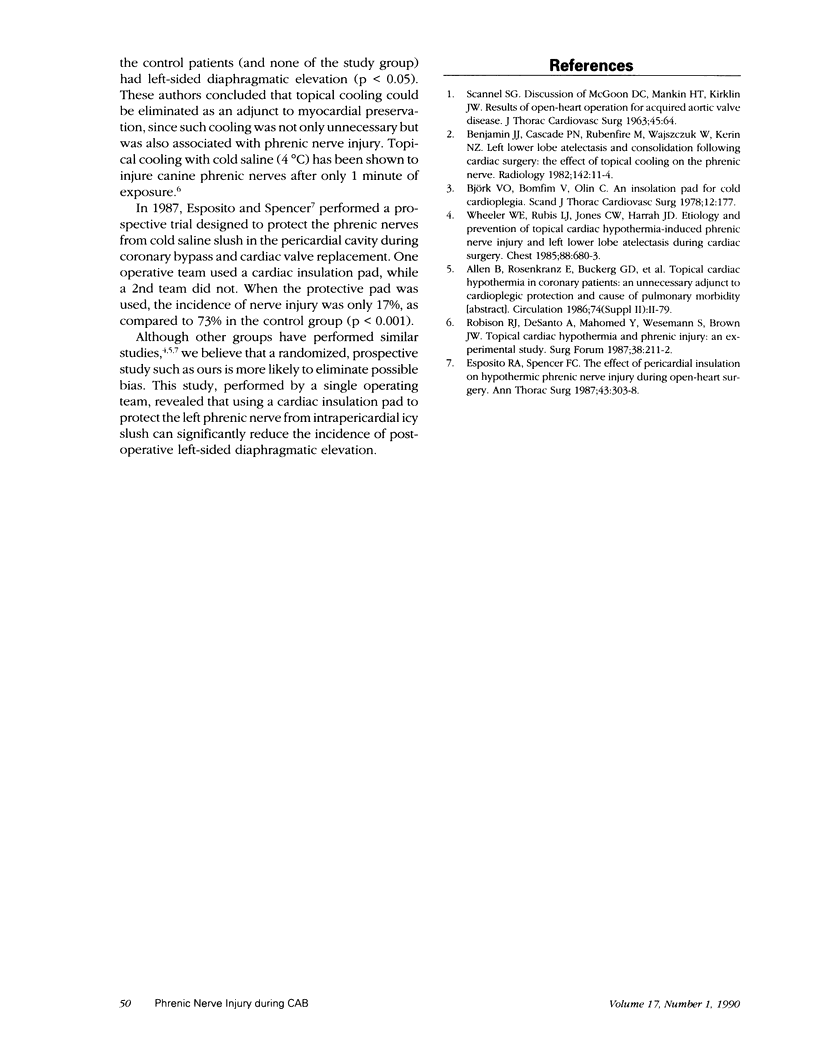Abstract
After coronary artery bypass, some patients have diaphragmatic elevation, usually on the left side. To test our hypothesis that this phenomenon is due to phrenic nerve injury resulting from either 1) dissection of the proximal portion of the left internal mammary artery or 2) topical cooling of the heart with icy slush, we performed the following 2-part study. First, we reviewed our hospital records of 99 coronary artery bypass patients, 55 of whom had received left internal mammary artery grafts and 44 of whom had undergone saphenous vein grafting; the results showed no significant difference between the rates of left-sided diaphragmatic paralysis in the 2 groups (47% versus 41%, respectively). Next, we performed a prospective, randomized study in 100 consecutive patients, using a cardiac insulation pad to protect the left phrenic nerve in 58 patients and using no protective pad in 42 patients. At the time of hospital discharge, left-sided diaphragmatic elevation was seen in 6 (10.3%) of the 58 patients in whom insulation had been used and in 19 (45.2%) of the 42 patients whose phrenic nerve had been unprotected (p < 0.001). We conclude that cooling of the left phrenic nerve with icy slush in the pericardial cavity causes left-sided diaphragmatic paralysis and that the frequency of this injury can be reduced if a cardiac insulation pad is placed between the nerve and the icy slush. (Texas Heart Institute Journal 1990;17:48-50)
Keywords: Aortocoronary bypass
Keywords: graft, internal mammary artery
Keywords: graft, saphenous vein
Keywords: respiratory paralysis
Keywords: heart arrest, induced
Keywords: hypothermia, induced
Keywords: phrenic nerve
Full text
PDF


Selected References
These references are in PubMed. This may not be the complete list of references from this article.
- Benjamin J. J., Cascade P. N., Rubenfire M., Wajszczuk W., Kerin N. Z. Left lower lobe atelectasis and consolidation following cardiac surgery: the effect of topical cooling on the phrenic nerve. Radiology. 1982 Jan;142(1):11–14. doi: 10.1148/radiology.142.1.6975951. [DOI] [PubMed] [Google Scholar]
- Björk V. O., Bomfim V., Olin C. An isolation pad for cold cardioplegia. Scand J Thorac Cardiovasc Surg. 1978;12(3):177–177. [PubMed] [Google Scholar]
- Esposito R. A., Spencer F. C. The effect of pericardial insulation on hypothermic phrenic nerve injury during open-heart surgery. Ann Thorac Surg. 1987 Mar;43(3):303–308. doi: 10.1016/s0003-4975(10)60619-4. [DOI] [PubMed] [Google Scholar]
- Wheeler W. E., Rubis L. J., Jones C. W., Harrah J. D. Etiology and prevention of topical cardiac hypothermia-induced phrenic nerve injury and left lower lobe atelectasis during cardiac surgery. Chest. 1985 Nov;88(5):680–683. doi: 10.1378/chest.88.5.680. [DOI] [PubMed] [Google Scholar]


